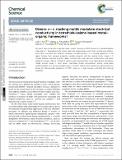Diverse π–π stacking motifs modulate electrical conductivity in tetrathiafulvalene-based metal–organic frameworks
Author(s)
Xie, Lilia S.; Alexandrov, Eugeny V.; Skorupskii, Grigorii; Proserpio, Davide M.; Dinca, Mircea
DownloadPublished version (1.409Mb)
Terms of use
Metadata
Show full item recordAbstract
We report three electrically conductive metal-organic frameworks (MOFs) based on a tetrathiafulvalene linker and La3+. Depending on the solvent ratios and temperatures used in their solvothermal synthesis, these MOFs crystallize with different topologies containing distinct π-π stacking sequences of the ligand. Notably, their transport properties correlate rationally with the stacking motifs: longer S⋯S contact distances between adjacent ligands coincide with lower electrical conductivities and higher activation energies. Diffuse reflectance spectroscopic measurements reveal ligand-based intervalence charge transfer bands in each phase, implicating charge delocalization among mixed-valent tetrathiafulvalene units as the dominant mode of transport. Overall, these frameworks demonstrate how tuning the intermolecular interactions in MOFs serves as a route towards controlling their physical properties.
Date issued
2019-07Department
Massachusetts Institute of Technology. Department of ChemistryJournal
Chemical Science
Publisher
Royal Society of Chemistry (RSC)
Citation
Xie, Lilia S. et al. "Diverse π–π stacking motifs modulate electrical conductivity in tetrathiafulvalene-based metal–organic frameworks." Chemical Science 37, 10 (July 2019): 8558-65 doi 10.1039/C9SC03348C ©2019 Author(s)
Version: Final published version
ISSN
2041-6539